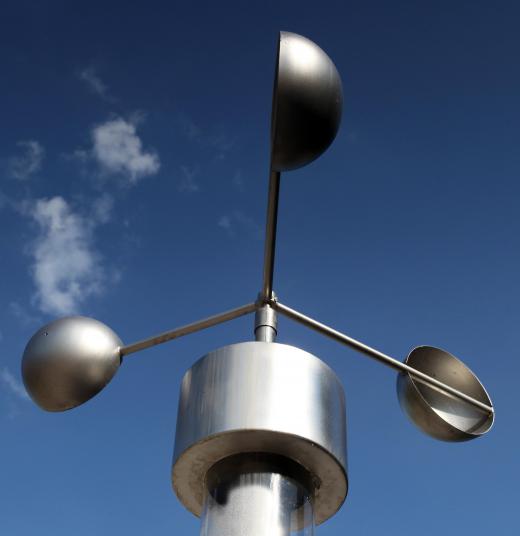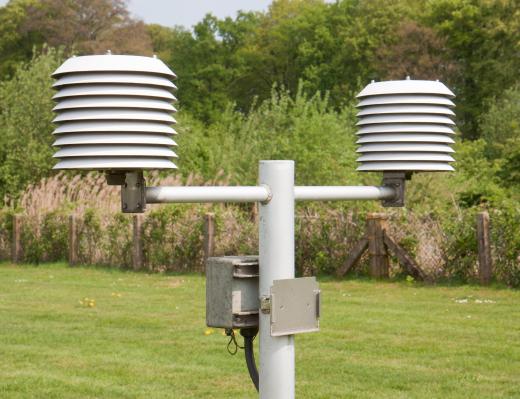What are Meteorological Instruments?
 Mary McMahon
Mary McMahon
Meteorological instruments are scientific instruments used in the study of weather. Studying the weather requires the use of equipment that can measure things like wind direction, humidity, atmospheric pressure, solar radiation, rainfall, temperature, wind speed, evaporation rate, and so forth. Other instruments assist people with visible observations, such as studying clouds and storm systems, recording visual data that can be perused or studied later and compared against other visual data from different locations and times.
These specialized scientific instruments are often made by companies that focus on just this type of equipment. These companies constantly conduct research to refine and improve their products, and to find new measuring methods that may be helpful for scientists. Meteorologists can order instruments through supplier catalogs or individual companies, and may sometimes work on the development of specialized custom instruments for particular applications. Customized equipment may be used for special weather investigations, including the study of weather on other planets, which can require some very unique devices.
For a weather station where scientists take continuous readings and observations, some meteorological instruments might include the following:
- barometers for pressure along with barographs to record pressure readings;
- thermometers for temperature;
- anemometers to measure wind speed;
- actinometers for solar radiation measurements;
- psychrometers for relative humidity;
- evaporimeters, also known as atmometers, to measure the evaporation rate;
- and weather vanes to indicate wind direction.
Many of these instruments can be attached to devices which take logs so that researchers can analyze the data they collect and access it remotely when they cannot visit the weather station in person.

Meteorologists also launch satellites to make weather observations from space, classically to record the movement of clouds and storm systems. They also use tools like weather balloons and radiosondes to make weather observations in the Earth's atmosphere. These devices include instrument packages that can take an assortment of measurements and either beam them back to a weather station or store them so that they can be access when the device is collected.

Some instruments used in meteorology are very old, while others are more recent inventions. Like other scientific instruments, meteorological equipment needs to be kept in good condition to take accurate measurements. Because it is exposed to the weather, special care must be taken to keep it clean and properly calibrated. Failure to maintain instruments can result in faulty readings, which would skew or compromise the data being collected. Instrument companies will often take them back for recalibration and repair by arrangement.
AS FEATURED ON:
AS FEATURED ON:



















Discussion Comments
Is there a tool that measures meteorological weather elements simultaneously in one device? I want to measure the thermal comfort of a room or comfort index, which is obtained from the calculation of the weather elements measured as the intensity of solar radiation, air temperature, wind speed, and humidity. If there is, what is the name of the tool, and where can I get it? Thank you.
Weather is so unpredictable, it is difficult even for expert weathermen to tell you if tomorrow will be a good day for a picnic or a good day for skiing. Today, the weather instruments are a lot better and predicting the weather is a lot more accurate. But, they still miss it a lot of the time.
When a serious weather event is coming, like a hurricane, or a tsunami, they can be predicted.
The weathermen know something about the course of a hurricane or tsunami, so you can try to get out of the area.
Tornadoes can be seen coming, but their path is a lot harder to predict. They twist and turn and change directions so fast, it's hard to get away. I can't imagine being in the path of one of those devils.
Hopefully, weather prediction and weather instruments will improve so we can predict weather better.
Back in the days of the Vietnam War, my cousin was in the U.S.Army and was stationed at a missile range. He worked as a weather specialist. His job was to take measurements of weather conditions like wind direction and speed, storms warnings, and temperature. He also sent up weather balloons to get information. He liked that part. They used this weather information to decide when to test missiles.
He had to study meteorology and learn how to use the instruments for measurement of weather conditions.
He was in this place for about a year and then was sent to Vietnam, where he did the same work.
Post your comments